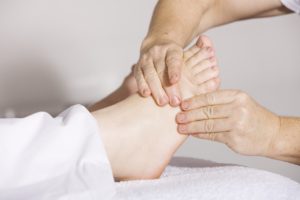What is Morton’s Neuroma and How to Fix It
Intermetatarsal neuroma, or simply known as Morton’s neuroma happens when the nerves between the toes get become swollen, typically causing sharp pain or even numbness in the toes. Normally, this happens between the third and fourth toe but swelling of the nerves can happen between the second and third toes. The nerve swelling happens when it becomes squeezed or irritated as it presses against the bones.

Image – Pixabay
Causes of Morton’s Neuroma
There isn’t a specific reason why this happens, but wearing tight, uncomfortable footwear is a big factor. High-heels or pointed shoes are the biggest culprits, and it’s no wonder that women have a higher chance of getting Morton’s neuroma when compared to men, especially once they reach their middle ages.
High-impact activities such as running cause repetitive trauma to your feet, especially if you have an abnormal gait. It is very important that you choose appropriate running footwear which have the proper arch support and can reduce pressure on the nerve.
Symptoms
Symptoms of Morton’s neuroma vary from person to person. In some cases, patients are diagnosed with Morton’s Neuroma even though they do not exhibit any of the symptoms. For most patients, symptoms include:
- Swelling between toes
- Tingling sensations and numbness
- Feels like there is a pebble under the ball of the foot when wearing shoes
- A sharp pain between the toes when walking
- Pain in the forefoot
Treating Morton’s Neuroma
Unfortunately, Morton’s neuroma won’t go away on its own, but the symptoms come and go according to your footwear and your daily activities. A doctor would first need to diagnose your problems by asking questions related to your pain. Then, he or she would examine your foot by pressing the areas in pain and look for inflamed areas. He would confirm the diagnosis by using imaging tests such as x-rays, ultrasound, or even magnetic resonance imaging (MRI).
Depending on the diagnosis, he or she may advise you to try treating it yourself at home. There are some at-home remedies you can try to provide some relief if your symptoms are not severe:
- Take a break from high-impact activities
- Doing an ice massage
- Take an over-the-counter anti-inflammatory medication such as ibuprofen to reduce the swelling and pain.
- Insert arch support and footpads inside your shoes
If these symptoms don’t recede, a doctor may suggest these options:
- Injections
The doctor may advise either a corticosteroid or alcohol sclerosing injection. Corticosteroid injections help in reducing swelling and inflammation but can cause negative side effects if not properly administered. Alcohol injections have indicated to reduce the size of Morton’s neuromas.
- Surgery
If symptoms persist, surgery is the only way. Typically, there are two options. The doctor can conduct a decompression surgery by removing structures near the nerves such as ligaments to reduce the pressure on the nerve or removing the nerve. This second option carries some risk as some patients may permanently feel numbness in the area.
For all the latest sports news follow PledgeSports on Facebook, Twitter, and Instagram.
